Home » Hunting Dogs » Red Grouse Counting in the North Highlands of Scotland
Red Grouse Counting in the North Highlands of Scotland
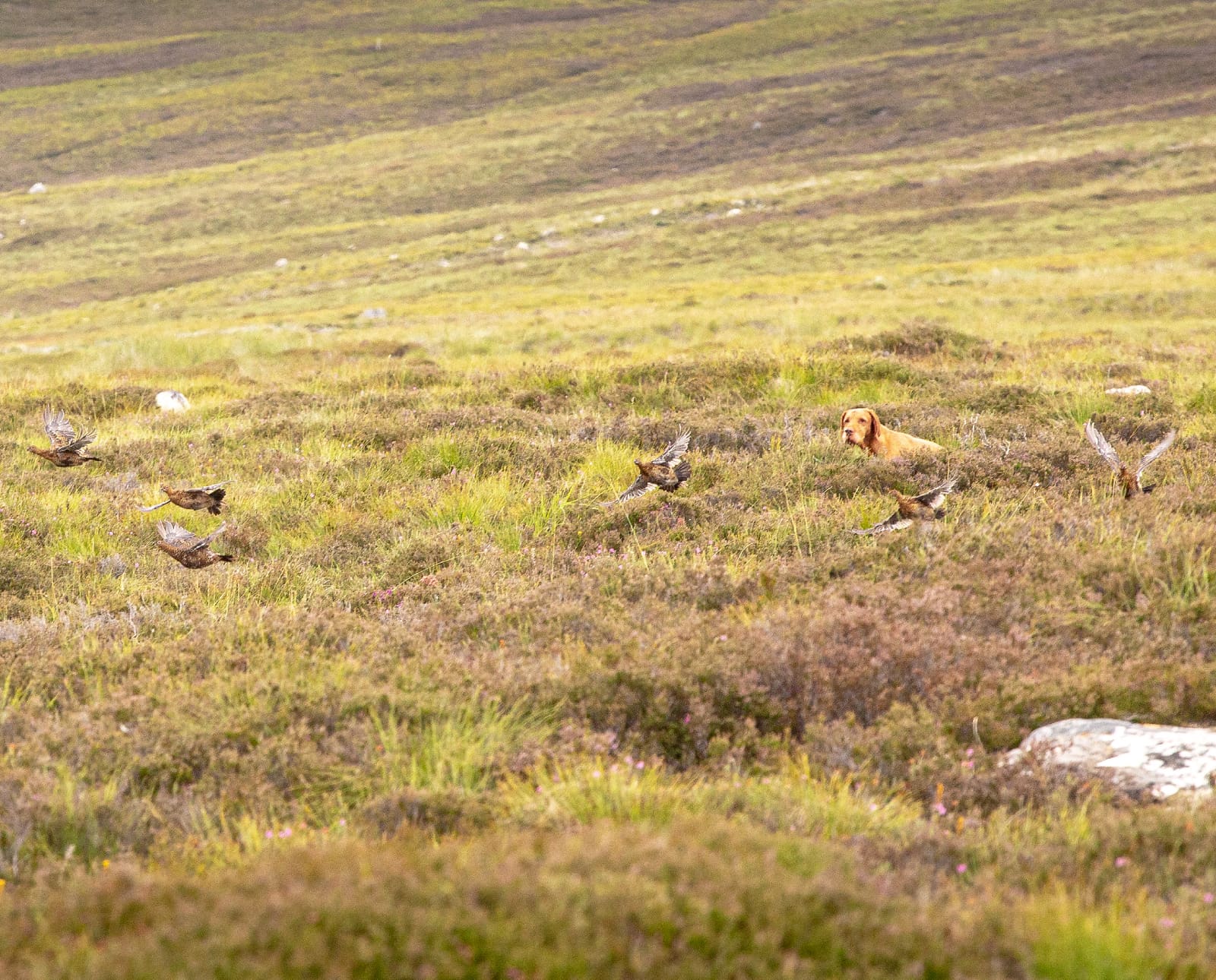
Georgina Buchan lives and works with her husband, Ronnie, and…
Explore the tradition and conservation of red grouse in Scotland with pointing dogs during the spring season.
July is an exciting month for us, as it signals the approach of our shooting season, which starts on 12 August—known as The Glorious Twelfth—with the opening of the red grouse season.
Listen to more articles on Apple | Google | Spotify | Audible
My husband Ronnie and I live on the northwest coast of Scotland with our ten Hungarian Wirehaired Vizslas. They are a huge part of our lives—they share our house and our sofas and are our family. The breed has a lovely temperament and a boundless willingness to please, making them a joy to live and work with.
Ronnie and I have been married for 32 years and during this time we have had many working dogs including spaniels, Labradors, retrievers, pointers, and an odd assortment of terriers. We finally settled on the Hungarian Wirehaired Vizsla breed and have not looked back! It all began nine years ago when I decided that I wanted my own dog to train, work, and compete with; now I have four Hungarian Wirehaired Vizslas that I’m proud to call my own.
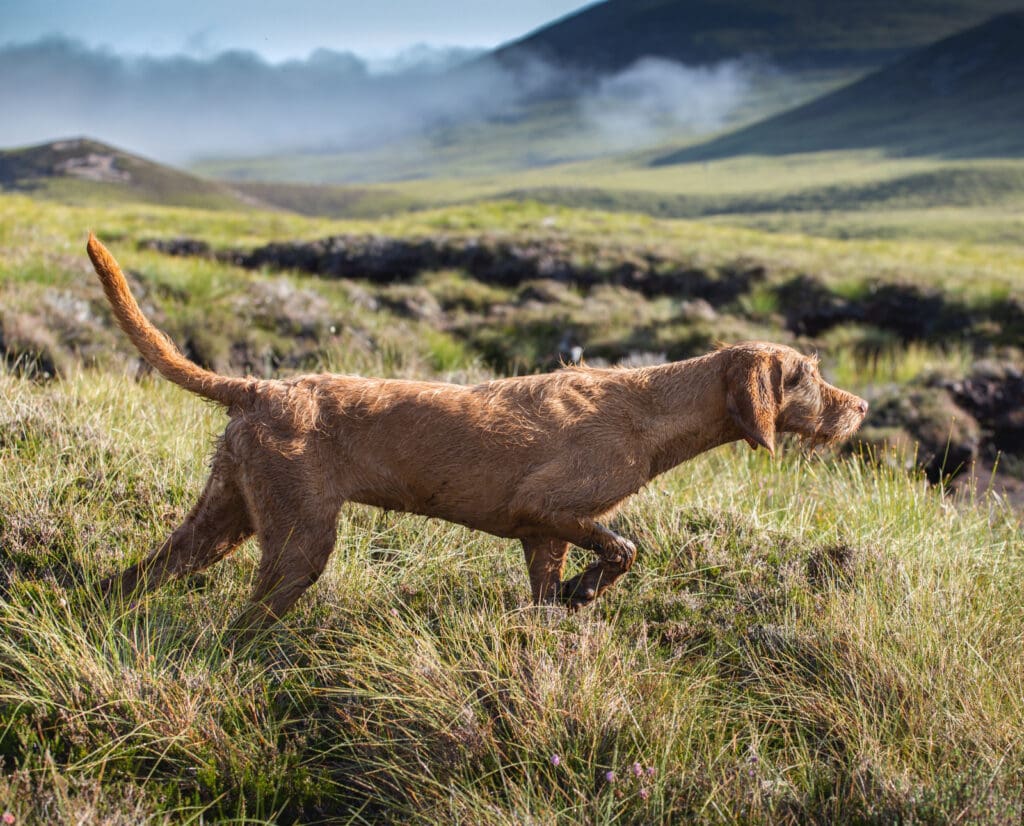
Spring and summer grouse counts
Our dogs have not been on the “hill,” which is what we call our open moorland, since the middle of April’s spring counts. This is so that we do not disturb the ground-nesting birds during their breeding and nesting season.
Spring counts usually begin at the end of March when the grouse pair up before breeding. We do a sample count on a particular piece of ground (block counting) to assess the number of grouse pairs that are present, as grouse are territorial during the breeding season. The same area of ground is then counted in the same way towards the end of July or the beginning of August constituting the summer counts. This gives us a good guide as to how well those grouse pairs have reproduced and how well the chicks fared.
Here on the northwest coast of Scotland, our grouse need all the help they can get. Our area is particularly harsh for the grouse with not much cover and varying degrees of bad weather. Both too much rain and too little can be detrimental. Young grouse chicks rely on a strict diet of insects for their first ten days of life but a cold May can delay insect hatch, jeopardizing the chicks’ survival.
Red grouse (Lagopus lagopus scotica) is a subspecies of the Willow Grouse, but unlike the Willow Grouse, it does not develop white plumage during the winter and it survives on a staple diet of mainly heather. The quality of heather has declined over the past few decades due to overgrazing by sheep and red deer as well as commercial forestry. Where we live, the crofters (small tenant farmers) like to burn the heather almost indiscriminately to improve the grass for the sheep. Whilst burning heather (“muirburn”) can be very good management for grouse too, it should be done in small patches rather than en masse. The grouse also must contend with vermin, some of which are protected by law.

The main reason for counting in July and early August is for the gamekeepers and the land managers to manage their upcoming shooting season. These men and women work hard throughout the year to manage their wild stock in the best way possible. Their work benefits not just the grouse but also a variety of wildlife on their ground, including the golden plover, snipe, curlew and lapwing.
Apart from running our dogs on our own ground where we live and work, we are often asked to help other gamekeepers and estate owners count their ground. This is a wonderful experience for us and our dogs because it gives us the opportunity to see different ground and spend time with like-minded people.
This year, we were very fortunate to be asked to help count a piece of ground in the Cairngorm mountain range. This was the first time we had been to that estate. The weather was very hot that week, so it meant an early start to beat the heat. We were on the hill by 7:00 AM, having driven two hours on main roads and then an hour up a dirt track road to get to where we needed to be. We worked a large piece of ground with seven dogs: four German Shorthaired Pointers and three Hungarian Wirehaired Vizslas.
To conduct the count, we spread out in a line and started off in the shadow of a very large hill with very wet ground thanks to a heavy dew. There was a lot of early morning mist that came and went, but for the first hour I could hardly see the handlers on either side of me. Unfortunately, there was absolutely no wind—not a breath—making conditions for the dogs very difficult. Our friend counting at the top of the line came across the most coveys, but the young were very immature and no doubt a product of a second clutch.
After an hour we came out of the shadow into bright sunlight and all the dogs instantly slowed down, as did their handlers. Another couple of hours of working the dogs in very challenging conditions brought us to the end of the “beat” where we congregated to discuss our morning. The wind was still non-existent, so the biting insects were out in force. We walked back to the trucks, parked next to a beautiful loch (lake) where the dogs could swim whilst we had a wonderful picnic and a good chat.
The total number of grouse counted was 60.
For comparison, the biggest number counted in previous years was 400 grouse. This year’s result was a huge reduction and very disappointing, but not unexpected. This ground sits at 1700 feet of elevation; in May they had a couple feet of snow that stayed on the ground for a week or so, followed by a very cold snap which would have restricted the insect life.
The scenery was absolutely breathtaking and, despite the lack of birds, we all enjoyed a most memorable morning. It is always impressive to see so many dogs working so well together.
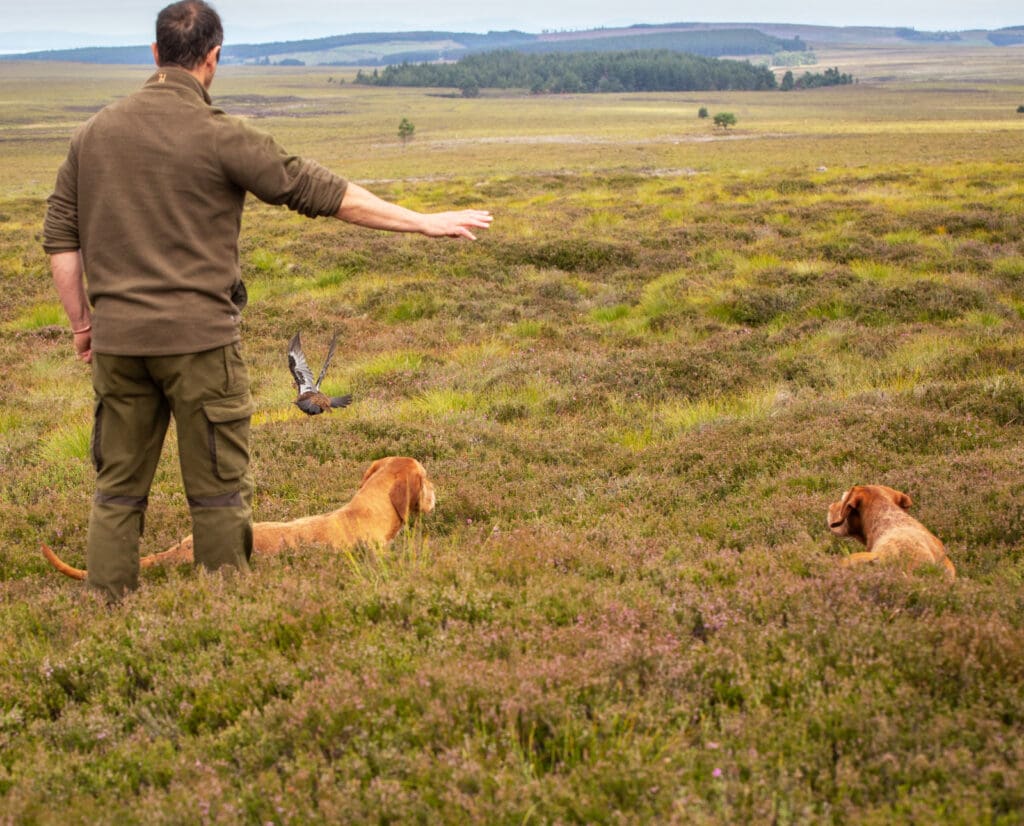
The role of the dogs during the count
Summer grouse counting requires cooperative and well-trained dogs. The dogs must be very steady because they often come across young chicks that cannot fly very well. If the adult birds lose their first lot of young, they can have a second clutch, but it’s usually a smaller hatching. These very young birds are evident when we are out counting; not only does this require perfect steadiness from the dogs, but we also have to be careful not to step on them!
There are also many mountain hares on our grouse moors, which can be quite challenging for some dogs. We do not have any hares or rabbits on the ground where we live and work, so our dogs are unaccustomed to the hares they encounter on a count; a sharp reaction to the stop whistle is key! We’re also likely to encounter sheep that act as “tick mops.” Ticks are very problematic for the Red Grouse because they pass on the Louping-Ill Virus, which can cause up to 80% loss of chicks. Red Grouse can also be severely affected by Strongylosis (Strongyle worm); to counter this, medicated grit prescribed by a veterinarian is put out on to the moor to control the parasite.
Watching dogs working the ground during a count is really quite wonderful. When they come on point, I always catch my breath, more so when our dogs are working with other dogs that they don’t know. The working partnership and respect that they show each other is impressive. There is nothing better than watching a dog use their amazing nose to work out where the birds are, followed by an explosion of grouse rising into the air and flying in all directions with the dog standing still, watching in awe.
I am also fascinated by the different styles of pointing among the dogs. Most of our dogs do not have docked tails, as it was illegal in Scotland until June 2018. Our youngest two dogs were born in November 2018, so they had a fraction of their tails docked. A few of our dogs stand stock-still on four legs when pointing, some with their tails up and some with their tails straight. A few will go into a crouch with a lifted front paw. A few will feather their tails until their point is solid. Reading the body language displayed by the dogs is so informative for the handler.
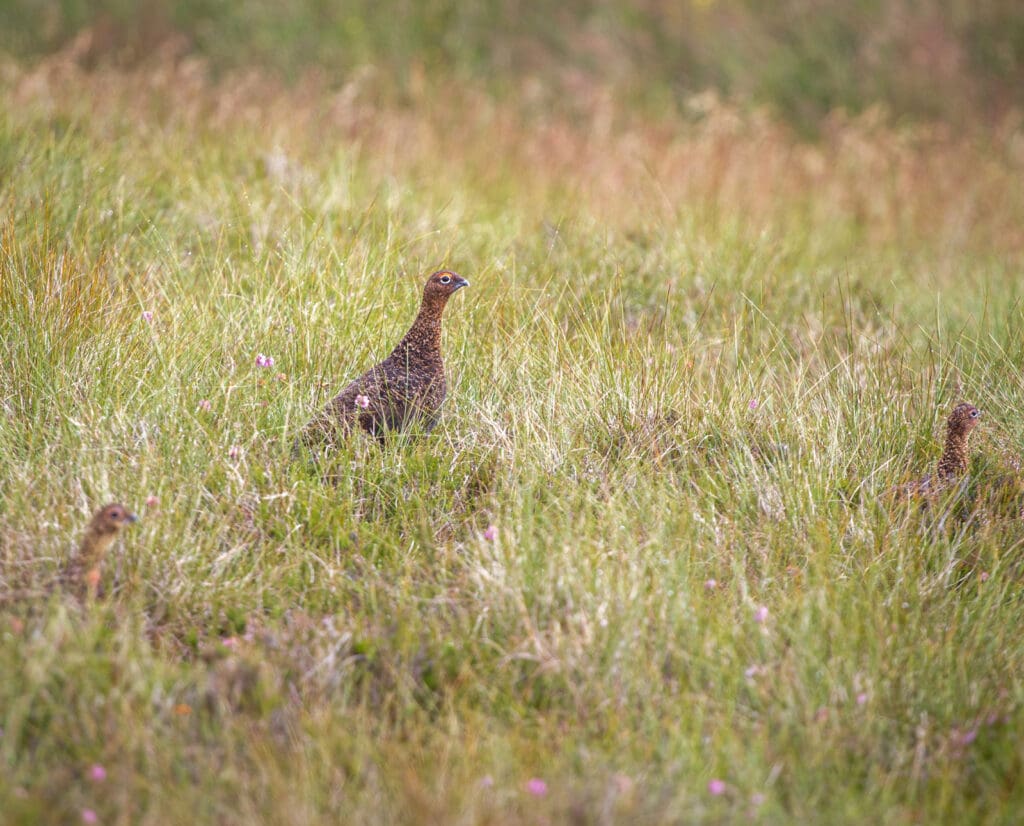
Results and observations from the season
On the whole, the summer grouse count this year has not been very good. A dumping of snow in May followed by a week or so of cold, hard weather has taken its toll on the young birds. A few of the estates where we have been counting have decided to cut back their shooting days, or changed their driven grouse days to shooting-over-pointers days.
We spent a day counting with some friends, one of whom came up from London for the summer counts, on a well-established Speyside grouse moor. Pointing dog owners will always jump at the chance to grouse count with their dogs!
We were due to count a number of separate blocks on the estate, the first being a flat piece of slightly wet ground comprised of medium-aged heather and blanket bog. The plan was to hunt this block to the far end, turn and hunt back again, thus splitting the block into two halves. All in all, before the offset it looked like a promising piece of ground to harbor grouse.
Conditions at the start were not ideal; it was very calm with a light back wind. However, the dogs coped with the conditions well, running out ahead of us and quartering back towards us to use what little wind there was to their advantage. Although a number of pairs were found on the outward hunt, we found very few young birds. On the return hunt, the ground was slightly more favorable with better wind, and we started to pick up a few strong, well-developed coveys.
Once back at the trucks, we concluded that the outcome of the count was a little disappointing in that numbers were reduced compared to previous years’ counts. This particular piece of ground will probably not be shot over this year.
Our next block of ground was a further five miles into the hills. The conditions were much better, with a proper breeze, despite it being a cheek wind. The ground was of good quality, with areas of well-burnt heather providing the perfect environment for grouse to thrive. After a slow start, we got into some strong coveys with high numbers of young birds. We also came across several mountain hares on this day, which always adds excitement for the dogs. We had a couple of great points on common snipe. Overall numbers on this second piece of ground were up on last year, meaning that at some point during the upcoming season this ground could possibly be shot over.
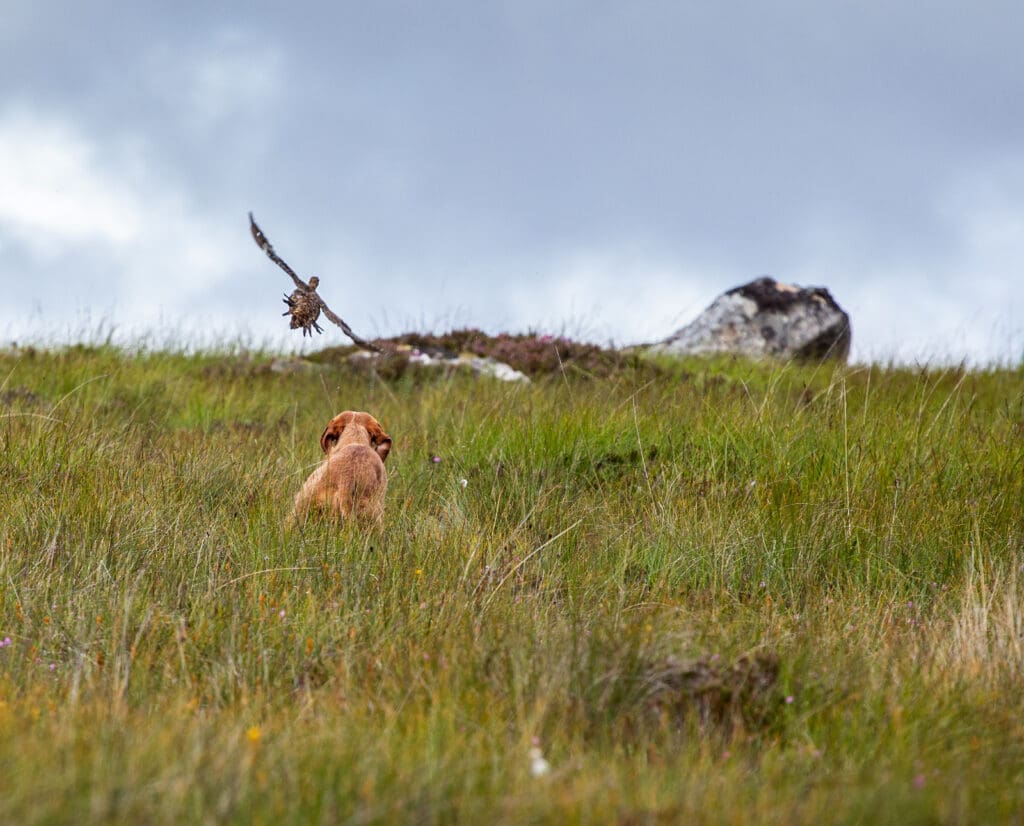
One of our favorite places to count grouse is in Perthshire. This particular count takes place a little later in the season because of the altitude of the ground that we count. This means that the birds’ breeding season takes place slightly later than on the lower grounds. The ground itself is a very long corrie, which is a high valley with a back wall and steep sides. It takes about an hour of walking to get ourselves into position to start the count. Four or five handlers with dogs line up the hill and start to walk the entire length of the corrie, working our dogs and counting grouse coveys as we go. We are all in radio contact with each other in order to make sure that no birds are double-counted. As the birds flush, we must quickly identify adult and young birds and record the information. Some estates also like to know the numbers of mountain hares and if any deer are seen. The entire morning is taken up counting one side of this corrie. Upon reaching the end of the first side, we stop for a well-deserved picnic lunch, after which we line up on the hill again to count the opposite side. The only disadvantage is that we usually have to work the dogs downwind on one side, which slows the process somewhat. Being the fittest out of the bunch, we normally have to take the high ground which means walking much further. But the best part of being on the high ground is that we often get points on ptarmigan. We love ptarmigan!
After the long and tiring day, we assemble for refreshments to compile all of our individual count figures.
On our home ground, the grouse numbers have never been historically high and, coupled with a few poor seasons weather-wise, we struggle to find enough birds to actually shoot. As a result, we will not be shooting them this year and possibly not even next year, instead working hard to improve their environment in the hope that we will have more successful breeding seasons to come.
Georgina Buchan lives and works with her husband, Ronnie, and their ten Hungarian Wirehaired Vizslas in the Northwest Highlands of Scotland. During their 35 years together, they have owned a variety of working dogs but have, for the moment, settled on the Hungarian Wirehaired Vizsla. They train, work and compete with their dogs who are a huge part of their lives and their family. She is a keen hunter, shooter, and fisherwoman who also has a passion for photography.

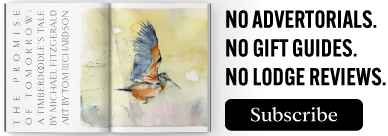


Great article. I have a home in the North West highlands, where I am a trustee of a very large community owned estate. We have red grouse, but not many, and we don’t shoot any of them. At the moment, I sort of check on the part of the estate nearest our home, using my lab and border terrier to flush. We aren’t very good, but it adds to our walks and fishing trips in late summer and early autumn.